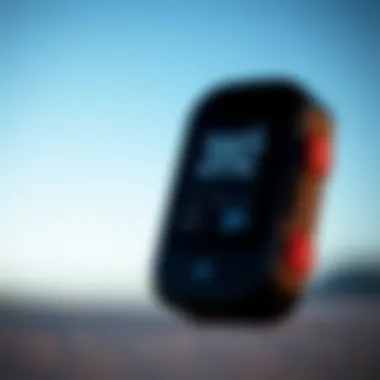Top Ten Oximeters: Your Comprehensive Buying Guide


Intro
Oximeters have become essential devices for many, serving as a bridge between health awareness and actionable insights. As our understanding of overall wellness evolves, monitoring oxygen saturation levels has gained importance not just for those with existing health conditions, but also for fitness enthusiasts keen on optimizing their workouts and recovery processes. It’s fascinating how such a small device can yield significant insights into our physical condition and well-being. In this article, we will explore the top ten oximeters on the market, examining not only their accuracy and usability but also the specific needs they cater to.
Whether you’re a health professional advising clients, a wellness coach supporting athletes, or simply someone who wishes to monitor their oxygen levels, knowing how to choose the right oximeter is crucial. This comprehensive guide will walk you through critical specifications, user demographics, and practical considerations, empowering you to make informed choices in a crowded marketplace.
Foreword to Oximeters
In the realm of health monitoring, oximeters play a crucial role, especially in today’s fast-paced world where wellness reigns supreme. These compact devices have gained traction not just among medical professionals but also among health enthusiasts seeking to keep an eye on their oxygen saturation levels. Understanding oximeters is essential, particularly for those in fitness and healthcare sectors. It’s not just about the technology; it’s about how this technology can impact lives.
What is an Oximeter?
An oximeter is a device designed to measure the oxygen saturation level in a person’s blood. It works by using light absorption properties to ascertain how much oxygen is being transported by hemoglobin in the bloodstream. This non-invasive method typically involves placing a small clip on a fingertip or earlobe.
Oximeters can range from simple models used at home to more complex, clinical-grade devices found in hospitals. They are quickly becoming a staple, not merely a gadget, as more individuals recognize the necessity for regular monitoring. With a user-friendly interface, many of today’s oximeters are designed for convenience and accuracy, and some even come with additional features like heart rate monitoring.
Importance of Monitoring Oxygen Levels
Monitoring oxygen levels is of paramount importance for various reasons. Low oxygen saturation can signal medical issues, such as respiratory disorders, thus prompting timely intervention. Here’s why tracking oxygen levels should be on everyone’s radar:
- Proactive Health Management: Regular tracking empowers users with information about their health status, enabling them to detect any abnormalities early and seek medical advice when necessary.
- Performance Optimization for Athletes: For fitness aficionados and athletes, knowing their oxygen levels can optimize performance and training regimens. In high-intensity sports, being aware of oxygen saturation can prevent reaching an overexertion state, which often leads to fatigue and reduced performance.
- Chronic Condition Monitoring: Individuals with chronic respiratory issues or heart conditions can benefit significantly from consistent monitoring. Oximetry can help guide treatment decisions, ensuring individuals manage their conditions effectively.
"Keeping tabs on oxygen saturation levels can be the difference between seamless activity and abrupt health issues."
In summary, oximeters are not just devices—they are gateways to understanding health dynamics better. As we proceed through this guide, we will delve deeper into the technology, evaluations, and practical applications of oximeters, retaining a steadfast focus on fostering well-informed choices in oxygen monitoring.
Understanding Oximeter Technology
Understanding oximeter technology is essential for anyone interested in monitoring oxygen levels reliably. These devices have evolved significantly over the years, becoming indispensable tools for healthcare professionals and even fitness enthusiasts. Knowing how they work can help users make informed choices, ensuring they select a model that meets their specific needs.
Pulse Oximetry Explained
Pulse oximetry is a non-invasive method of measuring blood oxygen saturation levels. This technology plays a critical role in diagnosing and managing various health conditions, including respiratory issues and cardiovascular diseases. By simply placing a small device on a fingertip or earlobe, one can obtain immediate feedback on oxygen levels, making it a user-friendly option for both medical and personal use.
A pulse oximeter works on the principle that oxygenated blood absorbs light differently than deoxygenated blood. This difference is leveraged to determine the hemoglobin saturation, expressed as a percentage. A normal reading typically ranges from 95% to 100%, with levels below 90% indicating potential health issues.
How Oximeters Work
Infrared Light Detection
The cornerstone of oximeter functionality lies in infrared light detection. When the device is activated, it emits light through the skin to measure how much of it is absorbed by the blood. Oxygenated hemoglobin absorbs light at different wavelengths than deoxygenated hemoglobin. By meticulously analyzing the light absorption, the oximeter can give a precise reading of blood oxygen saturation.
This method of infrared detection is often preferred because it allows for quick and non-invasive assessments, minimizing discomfort for the user.
Despite its advantages, infrared light detection does have shortcomings. For instance, poor circulation or nail polish can interfere with the readings, which is something users should keep in mind. Nonetheless, its rapid feedback makes it a popular choice for home and clinical settings alike.
Heart Rate Monitoring


Along with oxygen saturation levels, many modern oximeters also monitor heart rate. This feature is crucial, as heart rate can indicate a person's overall cardiovascular health. A typical oximeter will show beats per minute alongside oxygen saturation on its display, allowing for a comprehensive view of the user's current health status.
Heart rate monitoring is especially beneficial as it adds another layer of information that can signal potential health problems. For instance, consistently elevated heart rates might suggest anxiety or cardiovascular strain. The integration of this feature into oximeters makes them a versatile tool for gauging fitness and health conditions.
However, it is essential to understand that fluctuations in heart rate can stem from various factors, such as physical activity, stress, or even external temperature. Therefore, while heart rate data can be useful, it should be interpreted cautiously.
Criteria for Evaluating Oximeters
Choosing an oximeter involves more than just picking a device off the shelf. The making of such a choice requires a thoughtful evaluation of several criteria that ensure the device meets one’s specific health needs and lifestyle. This section illuminates the key elements, benefits, and considerations that go beyond the surface-level features of oximeters.
Calibration and Accuracy
Calibration and accuracy are paramount when assessing oximeters. An accurate reading could mean the difference between alerting someone to a health crisis and dismissing serious symptoms. As such, it’s crucial to delve into the specifics:
- Calibration methods: Some devices use factory calibration, while others allow users to adjust calibration settings. Understanding these differences can guide you in selecting a device right for your needs.
- Measurement accuracy: A quality oximeter should deliver precise SpO2 readings consistently within accepted parameters. Look for ratings that indicate the device’s reliability; clinically validated models often provide that assurance.
Employing calibration checks regularly can enhance accuracy. Many brands include instruction manuals detailing best practices for ensuring that readings remain valid. However, very few explain how to recalibrate manual devices, leading to potential inaccuracies over time. Thus, it’s wise to be aware of the model’s specific requirements and possibly consult the manufacturer's guidelines.
Ease of Use
When it comes to monitoring oxygen levels, simplicity often reigns supreme. An oximeter's ease of use has a direct impact on how frequently and accurately individuals will take their readings. Consider these factors:
- Display clarity: A bright, clear screen with large fonts ensures that readings are easy to read, even under less-than-ideal lighting situations.
- User interface: Intuitive controls can greatly affect the experience, especially for those who aren’t particularly tech-savvy. Touch or button controls should feel responsive and not overly complicated.
- Instructions: Compact and user-friendly manuals play a significant role. If the instructions are convoluted, the device might go unused, thereby negating its purpose altogether.
Whether a person is using an oximeter daily for health management or sporadically for fitness training, all these factors contribute to the overall user experience and adherence to regularly checking oxygen levels.
Portability and Design
A device might be packed with features, but if it’s cumbersome to carry, it loses its value. Portability and design should be key considerations for anyone looking to monitor oxygen levels on the go. Key points include:
- Size and weight: Lightweight and compact designs allow users to carry the device wherever they go, be it in a gym bag or a pocket. Look for options that integrate well into your daily routine without burdening you.
- Material quality: The build quality often reflects how well the device can withstand everyday wear and tear. Durable materials can prevent damage from accidental drops or exposure to moisture.
- Aesthetic: While functionality is most important, an appealing design might encourage more users to adopt the technology into their lifestyle, as it becomes something they don’t mind showing off.
Ultimately, portability and design enhance the likelihood of regular usage, which is crucial for effective health monitoring.
In summary, evaluating these criteria can make the difference between an oximeter that simply checks boxes and one that genuinely supports users in being proactive about their health. By prioritizing elements like calibration, ease of use, and design, buyers set themselves up for successful integration of these essential tools into their lives.
A Review of the Top Oximeters
When one thinks about health monitoring tools, oximeters often take center stage, particularly in the current climate of health awareness. In this section, we focus on reviewing the top oximeters available on the market today. It's imperative to understand that not all oximeters are created equal; factors such as accuracy, reliability, and ease of use can vary significantly. By providing detailed insights into these devices, buyers can make informed choices that suit their specific needs.
Oximeters serve as crucial devices in various sectors, from hospitals to personal fitness routines. With the rising popularity of at-home health monitoring, the demand for trustworthy oximeters has surged. This review not only highlights key features but also underlines the benefits, allowing potential users to weigh their options effectively. In making an investment in one of these devices, understanding the landscape of the market is essential, especially for health professionals and lay users alike.
Model Highlights
Here, we delve into several standout models that have garnered positive reception in the health community. Each of these oximeters has unique features, catering to a range of users.
- Nonin Onyx Vantage 9590: Renowned for its clinical-grade accuracy, this oximeter is often favored by medical professionals. It boasts a robust design along with user-friendly features, making it a top pick for consistent home monitoring.
- Zacurate Pro Series 500DL: This model is known for its wide usability, accommodating different finger sizes. Moreover, it delivers rapid readings, making it a great choice for athletes looking for quick assessments during training.
- SantaMedical Generation 2: Offering a combination of affordability and reliability, this oximeter performs admirably for both casual users and those with more serious health monitoring needs. Its sleek design adds to its appeal.


Each model reviewed here has been crafted to meet specific user desires, enhancing its place in the market. Nonetheless, it's vital to consider individual needs before making a decision.
Detailed Comparisons
When comparing various oximeters, several aspects come into focus that can significantly influence a user's experience:
- Accuracy: Precision is paramount, especially for those with health conditions requiring constant monitoring. Studies have shown that variance in readings can occur; choosing a model known for its reliability can mitigate these risks. For instance, the Nonin model frequently outperforms its competitors in clinical settings.
- Reading Speed: Some users might prefer devices that offer quicker responses. Brands like Zacurate have focused on producing models that give readings within seconds, satisfying the fast-paced environment often present in athletic scenarios.
- User Interface: An intuitive interface is critical for ease of use. A model like the SantaMedical clearly presents its readings, allowing users to understand their oxygen saturation levels without a hassle.
Choosing an oximeter shouldn’t be an afterthought; it is crucial for many individuals to monitor their oxygen levels accurately.
- Portability: Many oximeters excel in portability, with features like lightweight design and batteries included, which are important for outdoor use or travel. Models that fit comfortably in a pocket can enhance user experience, especially for athletes on the move.
In summary, these detailed comparisons pinpoint essential factors and guide users in selecting oximeters that are not just suitable but also reliable for their individual needs. As more advancements arise, staying updated on new models continues to be vital for those looking to maintain their health effectively.
Factors Influencing Purchase Decisions
When it comes to selecting the right oximeter, various factors come into play. These elements can shape one's experience and determine whether the purchase is a solid investment or a financial misstep. A careful examination of each aspect offers valuable insights, not only into the device itself but also into how well it meets individual health needs.
Price Range Analysis
One of the most significant considerations when purchasing an oximeter is price. These devices can range from rather affordable options around twenty dollars to high-end models that can cost two hundred dollars or more. The importance of understanding different price points cannot be overstated.
- Budget-Friendly: For those on a tighter budget, options like the Hertool Fingertip Pulse Oximeter provide reliable readings without breaking the bank. Despite the lower price, they still maintain decent accuracy and ease of use.
- Mid-Range Choices: If your pocket allows for a bit more wiggle room, devices like the Zacurate Pro Series 500DL often include extra features such as color displays and longer battery life.
- Premium Models: On the high end, the Masimo Rad-67 or Nonin Onyx Vets may offer advanced features like wireless connectivity or enhanced sensor technology for more demanding applications.
It's essential to align your expectations with price. Cheaper doesn’t necessarily mean inferior, but exploring the features offered at different price points is crucial in ensuring you're getting your money's worth.
User Reviews and Recommendations
When considering which oximeter to buy, feedback from other users can provide a glimpse into the practicalities of daily use. Reviews can reveal common pros and cons that specifications may not cover adequately.
- Hands-On Experience: Many users rave about the comfort and ease of using models like the iHealth Air due to their lightweight build and responsiveness. On various platforms, such as Reddit and health forums, talk flows about how easy these units are to handle.
- Functionality Insights: Others may share frustrations about certain oximeters, such as difficulty in getting accurate readings on individuals with darker skin tones, like noted in discussions about some lesser-known brands. This can lead to potential disappointments.
- Expert Recommendations: Health professionals often suggest oximeters based on user need. For example, fitness trainers might recommend devices that track pulse rate alongside oxygen saturation for athletes. These endorsements give credibility and can be very informative.
Ultimately, checking user reviews and recommendations can illuminate aspects of a device that may not be readily apparent. A thorough approach to these insights provides a wider lens to interact with the marketplace.
"Not all oximeters are created equal. Understanding the feedback from your peers can save time and money in the long run."
By considering price ranges and real users' experiences, buyers can formulate more confident decisions. This informed approach not only equips them with a tool tailored to their specific health needs but may also provide better value for money.
Practical Applications of Oximeters
The significance of oximeters extends far beyond simple readings of oxygen saturation. These devices are essential tools, particularly in contexts where monitoring health indicators is crucial. In this section, we’ll uncover the myriad practical applications of oximeters, diving into two critical arenas: home healthcare and athletic performance. Each use case underscores the effectiveness of these devices, highlighting benefits and considerations that may influence both users and healthcare professionals.
Use in Home Healthcare
In an age where at-home medical equipment is becoming ubiquitous, oximeters have carved out a notable niche within the home healthcare landscape. These devices provide a window into the respiratory health of patients, particularly those with chronic conditions such as asthma or COPD. By allowing individuals to monitor their oxygen levels from the comfort of their homes, oximeters facilitate timely interventions and adjustments to treatment protocols.
Here’s why their role is critical:


- Continuous Monitoring: Home healthcare patients can routinely check their oxygen saturation levels, thus catching potential dips before they escalate into emergencies.
- Empowerment: Patients gain a sense of control over their health, fostering proactive management of conditions and reducing reliance on frequent doctor visits.
- Customization: Doctors can tailor treatment plans based on the data collected, providing a deeper understanding of a patient’s day-to-day health fluctuations.
For instance, a COPD patient may use an oximeter to assess whether they’ve experienced changes in their breathing after engaging in physical activity. It helps them understand when to utilize rescue inhalers and aids in identifying patterns between physical exertion and oxygen levels.
Moreover, telehealth services are increasingly integrating oximeter data to enhance consultations, as this provides healthcare practitioners with precise information during virtual appointments. In this way, patients' home monitoring efforts can translate into actionable insights for their care teams.
Oximeters for Athletes
The realm of athletics welcomes oximeters as performance-enhancing tools, aiding athletes in understanding their stamina and cardiovascular capabilities. For athletes, oxygen levels can be a determining factor in endurance and overall performance. Here’s how oximeters are pivotal:
- Performance Optimization: Athletes often rely on precise measurement of oxygen saturation to gauge their exertion levels during training. A drop in oxygen levels can signal the body’s need for rest or adjustment in training intensity.
- Altitude Training: When training at high elevations, athletes can use oximeters to monitor their saturation levels, ensuring they're not experiencing adverse effects of altitude sickness.
- Recovery Tracking: Post-exercise, an athlete can use an oximeter to evaluate their recovery status, allowing them to make informed decisions about when to resume intense training.
"Monitoring oxygen levels allows me to fine-tune my training sessions. It’s not just a number; it’s a strategy to enhance performance and ensure recovery is on track."
Additionally, in sports medicine, coaches and trainers are starting to incorporate this technology into their routines to collect data on athletes' physiological responses to training regimens. This data can then inform coaching strategies and lead to better overall performance outcomes.
Future Trends in Oximeter Technology
The landscape of healthcare technology is continually evolving, and oximeters are no exception. Keeping a pulse on future trends in oximeter technology is vital, as it not only enhances user experience but also significantly improves health outcomes. The innovations in this field are shaping how patients monitor their oxygen levels, allowing for a more proactive approach to health management.
Advancements in Sensors
Recent years have seen significant strides in sensor technology. The traditional oximeter, which primarily utilizes photodetectors and infrared light, is being supplemented with advanced sensors that offer greater accuracy and responsiveness.
For instance, the development of multi-wavelength sensors allows for more precise readings by distinguishing between different types of hemoglobin. Higher accuracy means that deviations in oxygen saturation can be detected earlier, particularly critical in conditions like sleep apnea or chronic obstructive pulmonary disease (COPD). In addition, innovations such as thin-film nanostructures are paving the way for sensors that are smaller and less intrusive, making them easier to integrate into everyday wearables.
These advancements contribute not just to improved readings but also to user comfort and accessibility. Imagine a world where non-invasive sensors can continuously monitor oxygen levels without the need for traditional finger clip devices.
Integration with Mobile Apps
The integration of oximeters with mobile applications is an exciting frontier. With the proliferation of smartphones and wearable tech, users can now track their oxygen levels in real time right on their devices. This synergy between oximeters and apps offers a plethora of benefits such as real-time alerts for abnormal readings and historical data trends that can be shared with healthcare providers.
Not only does this integration provide convenience, but it also empowers users by fostering better engagement in their health management. Many applications even come with features that allow for personalized feedback, tailored exercise plans, and reminders for compliance with monitoring routines.
“The future of oximeter technology lies not just in the device itself but in the ecosystem of support it brings to health management.”
This convergence of technology and healthcare makes monitoring oxygen saturation seamless and less cumbersome, ensuring that users can keep a closer eye on their health whether they are at home or on the move. Furthermore, professionals like health coaches and fitness experts can leverage this wealth of data to provide customized guidance, amplifying the effectiveness of their programs.
In summary, advances in sensor technology and the seamless integration with mobile apps mark a turning point in how we utilize oximeters. These developments are making oxygen monitoring more accurate, convenient, and user-friendly, paving the way for a healthier tomorrow.
Culmination and Recommendations
In concluding this exploration into oximeters, it is pivotal to reflect on the key takeaways that can significantly influence your choice of device. Oximeters serve as indispensable tools in both daily health management and professional healthcare settings, making the selection process crucial for optimal results.
Choosing the Right Oximeter
Selecting the ideal oximeter requires a blend of understanding personal or professional needs and evaluating the features available. Here are key elements to consider:
- Accuracy: The precision of oxygen saturation readings can vary. Look for models that have been clinically validated, which ensures they provide reliable data.
- Ease of Use: A user-friendly design is essential, especially if the device will be used by different individuals or in a clinical environment. Check for large displays, simple interfaces, and clear instructions.
- Portability: If you plan to use the oximeter on the go, weight and battery life become significant factors. Small, lightweight options will ensure you can have it handy without hassle.
- Price: There's a broad spectrum of prices in the oximeter market. While a higher price often correlates with advanced features, it is important to find a balance between affordability and functionality.
Before purchasing, it's advisable to read reviews, particularly those from professionals or users who have similar needs. Individual preferences can play a hefty role, so consider what other users mention about real-life performance.
Summary of Key Insights
To wrap things up, oximeters are more than mere gadgets — they are crucial devices that contribute to health monitoring. A few fundamental insights include:
- Oximeters are vital tools for monitoring oxygen levels, especially for individuals with pulmonary conditions or athletes in training.
- Not all oximeters are created equal; knowing what to look for ensures you choose a reliable model that fits your requirements.
- Future enhancements, such as improved sensor technology and mobile app integrations, promise to make these devices even more useful and versatile.
Ultimately, understanding what you need from an oximeter paves the path toward making an informed decision. For those in health professions or personal wellness, being proactive is key. Always remember: keeping an eye on oxygen levels is not just smart; it’s essential in safeguarding well-being.
By aligning your choice with individual requirements and informed insights, you help to ensure the efficacy of your health regimen.















